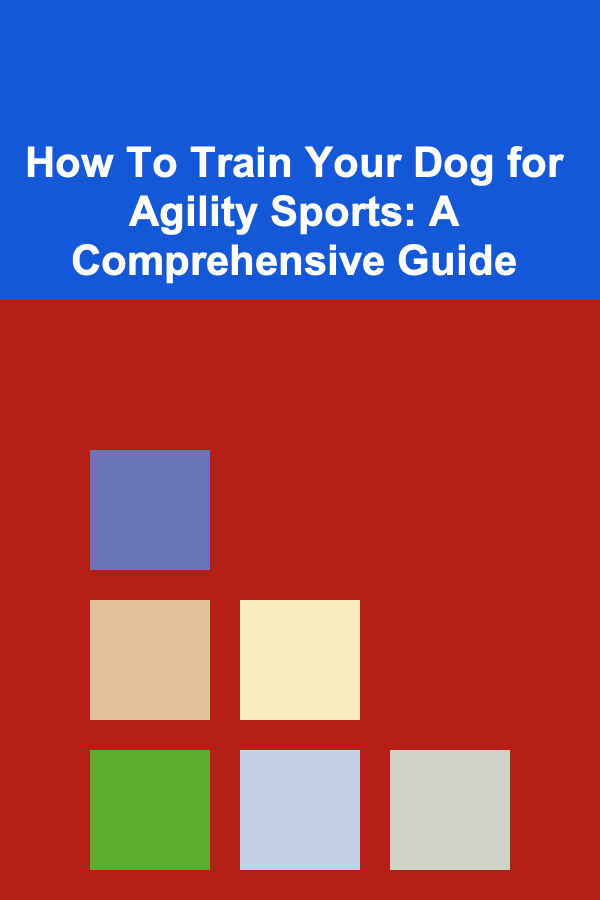
How To Train Your Dog for Agility Sports: A Comprehensive Guide
ebook include PDF & Audio bundle (Micro Guide)
$12.99$6.99
Limited Time Offer! Order within the next:

Introduction: The Thrill of Agility
Agility is more than just a sport; it's a dynamic partnership between you and your dog. It's a test of speed, precision, and communication, requiring your dog to navigate a challenging obstacle course under your guidance. The sheer joy on a dog's face as they leap over jumps, weave through poles, and scramble through tunnels is infectious. Beyond the competitive aspect, agility training strengthens the bond between you and your canine companion, enhances their physical and mental well-being, and provides a fantastic outlet for their energy.
This guide aims to provide a comprehensive roadmap for training your dog for agility sports. We'll cover everything from foundational obedience skills to mastering advanced agility obstacles, focusing on positive reinforcement methods and building a strong, trusting relationship with your dog.
I. Laying the Foundation: Essential Obedience Skills
Before you even think about introducing your dog to agility obstacles, it's crucial to establish a solid foundation of basic obedience skills. These skills will not only make agility training easier but will also ensure your dog's safety and well-being on the course.
A. Core Commands: The Building Blocks
The following commands are essential for successful agility training:
- Sit: A reliable sit is fundamental for controlling your dog's position and preventing them from bolting ahead.
- Stay: This command is crucial for teaching your dog to remain in a specific spot while you move to the next obstacle. Start with short durations and gradually increase the time.
- Down: Similar to "sit," "down" provides another way to control your dog's position, especially helpful for waiting at the start line or in between obstacles.
- Come: A reliable recall is paramount, not only for agility but also for your dog's overall safety. Practice recall in various environments and distractions.
- Leave It: This command teaches your dog to ignore tempting distractions on the course, such as toys or food dropped by accident.
- Heel: While not directly used on the agility course, heeling helps establish your leadership and control, making your dog more receptive to your cues.
B. Positive Reinforcement: The Key to Success
Positive reinforcement involves rewarding your dog for desired behaviors. This can be done using treats, praise, toys, or even a simple scratch behind the ears. The key is to find what motivates your dog and use it consistently during training.
Key principles of positive reinforcement:
- Timing is crucial: Reward your dog immediately after they perform the desired behavior. This helps them associate the behavior with the reward.
- Consistency is key: Use the same commands and rewards consistently to avoid confusing your dog.
- Keep it fun: Training should be enjoyable for both you and your dog. If either of you are getting frustrated, take a break.
- Fade the lure: Initially, you may use a treat to lure your dog into the desired position. Gradually reduce your reliance on the lure and rely more on verbal cues.
- Variable reinforcement: Once your dog understands the command, start using variable reinforcement. This means rewarding them sometimes but not always, which will keep them motivated and engaged.
C. Clicker Training: A Powerful Tool
Clicker training is a specific form of positive reinforcement that uses a clicker to mark the exact moment your dog performs the desired behavior. The clicker sound becomes associated with a reward, creating a clear and consistent signal for your dog.
Benefits of clicker training:
- Precise timing: The clicker allows you to mark the exact moment of the desired behavior, even if it's a fleeting movement.
- Clear communication: The consistent sound of the clicker eliminates ambiguity and helps your dog understand what you want them to do.
- Increased motivation: Clicker training can be highly motivating for dogs because they quickly learn that the clicker means a reward is coming.
To start clicker training, you need to "charge" the clicker by pairing the click with a reward. Click the clicker and immediately give your dog a treat. Repeat this several times until your dog associates the click with positive reinforcement.
II. Introducing Agility Equipment: One Step at a Time
Once your dog has a solid foundation in basic obedience, you can start introducing them to agility equipment. It's crucial to introduce each obstacle gradually and positively, ensuring your dog feels comfortable and confident.
A. The Importance of Safety
Before introducing any equipment, make sure your training area is safe. Clear away any potential hazards, such as sharp objects or slippery surfaces. Ensure that your dog is physically fit and free from any injuries. If you have any concerns about your dog's health, consult with your veterinarian before starting agility training.
B. Start with Low-Impact Obstacles
Begin with obstacles that are low to the ground and easy for your dog to navigate. This will help build their confidence and prevent injuries.
- Jumps: Start with the bar very low or even on the ground. Encourage your dog to walk or step over the bar, rewarding them as they do. Gradually increase the height of the bar as your dog becomes more comfortable.
- Tunnels: Tunnels are often a favorite among dogs. Start with a short, straight tunnel and encourage your dog to run through it using a toy or treat as a lure. Gradually increase the length and add curves to the tunnel.
- Weave Poles: Weave poles can be challenging for some dogs. Start by leading your dog through the poles one at a time, rewarding them as they weave. You can use a target stick or lure to guide them. Gradually increase the number of poles as your dog progresses.
C. Gradual Progression and Positive Reinforcement
The key to success is to progress gradually and use positive reinforcement every step of the way. Never force your dog to do anything they're not comfortable with. If they hesitate or show signs of fear, back up a step and make the exercise easier. Focus on building their confidence and making the experience fun.
Tips for introducing agility equipment:
- Keep training sessions short and positive: End each session on a positive note, even if your dog only makes small progress.
- Use high-value rewards: Use treats or toys that your dog finds particularly motivating.
- Be patient and consistent: It takes time and patience to train a dog for agility. Don't get discouraged if your dog doesn't learn everything overnight.
- Listen to your dog: Pay attention to your dog's body language. If they seem stressed or uncomfortable, stop the training session and try again later.
D. Specific Obstacles: Techniques and Tips
1. The Jumps
Jumps come in various forms, including single bars, double bars, and spread jumps. The key is consistent stride and clear communication. Start low, rewarding clean jumps with no knocking of the bar.
Training Tips:
- Approach Angle: Work on your approach angle. A straight approach will generally result in a better jump.
- Verbal Cues: Use a consistent verbal cue (e.g., "Over") just before the jump.
- Distance Control: Gradually increase the distance between you and the jump, teaching your dog to maintain speed and accuracy.
2. The Tunnels
Most dogs love tunnels. The challenge comes in maintaining speed and accuracy through longer, curved tunnels.
Training Tips:
- Enticement: Use a toy or treat to encourage your dog to enter the tunnel initially.
- Tunnel Directionals: As the tunnels get longer, start using directional cues ("Tunnel Left," "Tunnel Right") to guide your dog.
- Speed Control: Practice sending your dog through the tunnel from a distance, gradually increasing the distance and requiring faster speeds.
3. The Weave Poles
Weave poles are often considered one of the most challenging obstacles to teach. Patience and consistency are key.
Training Methods:
- Channel Method: Use two rows of poles, gradually narrowing the gap between them as your dog gains confidence.
- 2x2 Method: Start with two sets of two poles, spaced slightly apart. Teach your dog to weave through each set. Gradually move the sets closer together until they become a standard set of weave poles.
- Lure Method: Use a lure to guide your dog through the poles, rewarding them as they weave correctly.
Common Weave Pole Mistakes:
- Dropping Poles: If your dog is consistently dropping poles, they may be going too fast or may not understand the weaving pattern. Slow down and focus on accuracy.
- Entering the Wrong Side: Make sure your dog always enters the poles on the correct side (usually the right). Use clear verbal cues and physical guidance if necessary.
4. The Dog Walk
The dog walk consists of a raised plank with an ascending ramp, a level section, and a descending ramp. Safety is paramount; teach your dog to enter and exit confidently.
Training Tips:
- Low and Slow: Start with the dog walk on the ground, teaching your dog to walk across the plank.
- Gradual Elevation: Gradually raise the dog walk as your dog becomes more comfortable.
- Contact Zones: Teach your dog to touch the contact zones (the colored areas at the bottom of the ramps) with at least one paw. This is often a requirement in agility competitions.
5. The A-Frame
Similar to the dog walk, the A-frame consists of two ramps that meet at the apex. Again, contact zones are crucial.
Training Tips:
- Start Low: Begin with the A-frame lowered, creating a shallow angle.
- Consistent Cues: Use a consistent verbal cue ("A-Frame") as your dog approaches the obstacle.
- Contact Zone Training: Emphasize contact zone training, rewarding your dog for touching the contact zones with at least one paw.
6. The Teeter-Totter (Seesaw)
The teeter-totter can be intimidating for some dogs due to the movement and noise. Desensitization and positive reinforcement are key.
Training Tips:
- Desensitization: Let your dog investigate the teeter-totter while it's stationary. Reward them for approaching and sniffing it.
- Gradual Introduction: Start with the teeter-totter blocked, so it doesn't move. Gradually decrease the amount of blocking as your dog becomes more comfortable.
- Controlled Movement: Guide your dog across the teeter-totter slowly and deliberately, rewarding them as it tips.
- Full Contact: Ensure your dog runs fully across the teeter-totter until it hits the ground on the other side.
III. Refining Your Skills: Advanced Agility Training
Once your dog is comfortable with all the agility equipment, you can start refining their skills and working on more advanced techniques.
A. Course Sequencing and Handling Techniques
Agility courses are designed to test your dog's speed, accuracy, and obedience. Learning to effectively sequence the obstacles and use appropriate handling techniques is crucial for success.
Common handling techniques:
- Front Cross: A front cross involves you crossing in front of your dog as they approach an obstacle, signaling them to turn in the opposite direction.
- Rear Cross: A rear cross involves you crossing behind your dog as they approach an obstacle, signaling them to continue in the same direction.
- Blind Cross: A blind cross is a more advanced technique where you cross behind your dog, but they cannot see you. This requires excellent communication and trust.
- Motion/Verbal Cues: Combining body language and verbal commands to clearly communicate the desired path to your dog.
B. Building Speed and Endurance
Agility is a physically demanding sport, so it's important to build your dog's speed and endurance. This can be done through regular exercise, such as running, swimming, or playing fetch.
Tips for building speed and endurance:
- Interval training: Alternate between periods of high-intensity exercise and periods of rest.
- Hill work: Running uphill can help build strength and endurance.
- Cross-training: Incorporate other activities, such as swimming or biking, to prevent overuse injuries.
C. Troubleshooting Common Problems
Even with the best training, you're likely to encounter some problems along the way. Here are some common issues and how to address them:
- Refusal to enter obstacles: This may be due to fear or lack of confidence. Go back to basics and reintroduce the obstacle gradually.
- Knocking down bars: This may be due to poor jumping technique or lack of focus. Lower the bar and focus on improving your dog's form.
- Running off course: This may be due to distractions or lack of clear communication. Minimize distractions and work on your handling skills.
D. Mental Stamina: Focus and Concentration
Physical endurance is important, but so is mental stamina. An agility course requires intense focus, and your dog needs to maintain concentration amidst distractions and excitement.
Exercises to improve mental stamina:
- Duration Training: Gradually increase the length of your training sessions, focusing on maintaining focus throughout.
- Distraction Training: Introduce distractions during training, such as other dogs, people, or toys. Reward your dog for maintaining focus despite the distractions.
- Impulse Control Games: Play games that require your dog to control their impulses, such as "wait" or "leave it."
IV. Competition and Beyond: Reaching Your Agility Goals
Once you and your dog are ready, you can start competing in agility trials. Competition provides a fun and challenging way to test your skills and see how you measure up against other teams.
A. Finding and Preparing for Agility Trials
There are many different agility organizations, each with its own rules and regulations. Research different organizations and find one that aligns with your goals and values.
Tips for preparing for agility trials:
- Practice in a trial-like environment: Set up courses that mimic those used in agility trials.
- Attend practice matches or run-throughs: This will help you and your dog get used to the atmosphere of a trial.
- Pack a trial bag: Include everything you need for the trial, such as treats, toys, water, a crate, and comfortable shoes.
B. Handling Trial Day Nerves
It's normal to feel nervous on trial day, but it's important to stay calm and focused. Remember that agility is supposed to be fun, so try to relax and enjoy the experience.
Tips for managing trial day nerves:
- Breathe deeply: Take slow, deep breaths to calm your nerves.
- Visualize success: Imagine yourself and your dog successfully completing the course.
- Focus on your dog: Pay attention to your dog's needs and try to make them feel comfortable and confident.
C. Beyond Competition: The Enduring Bond
Whether you choose to compete or not, agility training can provide immense benefits for both you and your dog. It strengthens your bond, enhances your dog's physical and mental well-being, and provides a fun and rewarding activity that you can enjoy together for years to come. Remember that the most important thing is to have fun and celebrate the journey you're taking with your canine partner.
V. Maintaining Your Dog's Physical Health for Agility
Agility places significant demands on a dog's body. Prioritizing their physical health is critical for both performance and longevity in the sport.
A. Warm-up and Cool-down Routines
Just like human athletes, dogs benefit from proper warm-up and cool-down routines. These routines prepare their muscles for the demands of agility and aid in recovery.
Warm-up exercises (5-10 minutes):
- Light Cardio: Brisk walking or trotting to increase blood flow to the muscles.
- Range-of-Motion Exercises: Gentle stretches that target major muscle groups, such as shoulder rotations, leg extensions, and back arches (performed carefully and only if your dog is comfortable).
- Targeting Exercises: Short, easy exercises using a target stick or mat to encourage controlled movement and body awareness.
Cool-down exercises (5-10 minutes):
- Slow Walking: Gradually decrease the intensity of your dog's activity.
- Gentle Stretching: Repeat some of the range-of-motion exercises from the warm-up.
- Massage: A gentle massage can help relax the muscles and promote blood flow.
B. Nutrition and Hydration
A balanced diet and adequate hydration are essential for maintaining your dog's energy levels and supporting their physical health.
Nutritional considerations:
- High-Quality Dog Food: Choose a dog food that is specifically formulated for active dogs and contains a high percentage of protein.
- Supplementation: Consider adding supplements such as glucosamine and chondroitin to support joint health. Consult with your veterinarian before adding any supplements to your dog's diet.
- Feeding Schedule: Feed your dog a few hours before or after agility training to avoid digestive issues.
Hydration:
- Water Availability: Always have fresh water available for your dog, especially during and after training.
- Electrolyte Replacement: Consider adding an electrolyte supplement to your dog's water after intense training sessions.
C. Veterinary Care and Preventative Measures
Regular veterinary checkups are essential for detecting and treating any potential health problems. Preventative measures, such as vaccinations and parasite control, are also crucial for maintaining your dog's overall health.
Key considerations:
- Annual Checkups: Schedule annual checkups with your veterinarian to ensure your dog is healthy and fit for agility.
- Vaccinations and Parasite Control: Keep your dog up-to-date on all vaccinations and parasite control medications.
- Joint Health: Discuss joint health with your veterinarian and consider preventative measures, such as glucosamine and chondroitin supplements.
- Dental Health: Maintain good dental hygiene to prevent dental problems.
D. Recognizing Signs of Injury
Being able to recognize the signs of injury is crucial for preventing more serious problems. If you notice any of the following signs, consult with your veterinarian immediately:
- Lameness: Limping or favoring one leg.
- Swelling: Swelling around joints or muscles.
- Pain: Vocalization or flinching when touched.
- Stiffness: Difficulty moving or reluctance to move.
- Changes in Behavior: Decreased appetite, lethargy, or irritability.
Conclusion: The Rewarding Journey of Agility
Training your dog for agility sports is a rewarding journey that strengthens your bond, enhances their well-being, and provides countless hours of fun and excitement. By following the principles outlined in this guide, you can help your dog reach their full potential and enjoy the thrill of agility for years to come. Remember to be patient, consistent, and always focus on positive reinforcement. Most importantly, have fun and celebrate the amazing partnership you share with your canine companion!

How to Make Money Using Pretrained Deep Learning Models
Read More
How to Organize Travel Guides and Maps in Your Library
Read More
How to Stage Your Home for Eco-Conscious Buyers
Read More
How to Understand and Compare Investment Options
Read More
What Are the Best Tips for Organizing Your Jewelry Collection?
Read More
How To Interpret Blockchain Performance Metrics
Read MoreOther Products

How to Make Money Using Pretrained Deep Learning Models
Read More
How to Organize Travel Guides and Maps in Your Library
Read More
How to Stage Your Home for Eco-Conscious Buyers
Read More
How to Understand and Compare Investment Options
Read More
What Are the Best Tips for Organizing Your Jewelry Collection?
Read More